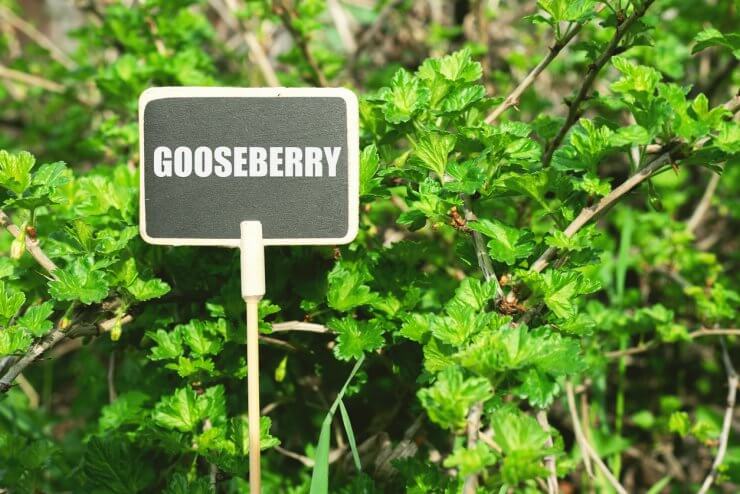
Gooseberry tree branches in the garden
Gooseberries will grow happily in partial shade; in fact, they prefer a cool, moist spot to a blazing hot spot. The gooseberry is the perfect candidate to reside in a northern exposure part of your garden. They can get by with just three hours of direct sun a day—six would be better, but three will do.
If you live in an area where the temperature rises above 85 degrees F, you actually may need to give your plant some shade from the midday sun. Scope out your potential locations and find one that will give your gooseberry bushes some afternoon shade; they’ll be much happier. And make sure the soil drains well; like so many fruiting plants, gooseberries don’t like wet feet!
Acclimation
If you purchase a container-grown gooseberry plant, you can plant it as soon as it’s acclimated to your area. Give it a week or two in your planned spot and see how it does (don’t forget to water it!). If it does well in that spot, you’re ready to plant. If you need to, try another spot.
If you get a bare-root plant, you’ll want to plant it right away. Bare-root plants often ship in the fall and should be planted shortly after delivery. You could try to overwinter your plant, but you run the risk of it breaking dormancy even if you have stored it in a suitable cold, dark space. Better to plant it in the ground.
Planting

Gooseberry cane ready for planting
Before you plant your gooseberry bushes, make sure you’ve tested your soil and you’ve amended it to the pH gooseberries like—5.5 to 7.0.
When you’re ready to plant your gooseberry bush, if it’s in a container, gently remove it, keeping the soil intact. Check the root system; cut off roots that are wrapped around the root ball. If it’s a bare-root plant, it should be ready to go. Protect the roots from direct sunlight during this process.
Dig a hole that’s deeper and wider than the root system. Put the plant into the hole with the lower branches a little below the soil level; this will encourage the plant to develop into a bush form. If you’re planning to prune your gooseberry into a “standard” shape so it looks more like a tree, keep the lower branches level with the soil; you’ll be pruning them later. Fill in the hole with the soil, then water and apply (only in spring) a balanced 10-10-10 fertilizer. Don’t fertilize if you’re planting in the fall. If your soil is good but not great, consider filling in the hole with half the soil you dug out and the remaining half with amended garden soil (Miracle-Gro and other companies sell soil especially for this purpose).
Plant Spacing
If you’re planting more than one gooseberry bush, first consider how you’re going to let it grow: as a bush, trained along a wall or trellis, or as a “standard,” tree-like shape. You want to plant your gooseberries at least 4 to 5 feet apart—unless, of course, you’re planning to plant gooseberries as a natural hedge. In that case, a 2-foot spacing is a good idea.
One other advantage of planting more than one gooseberry of the same cultivar is pollination. While most gooseberry plants are self-fertile, having two plants will give you a more fruitful harvest from each one.
Companion Planting
Gooseberry plants can benefit from the company of other plants:
Beans: Broad beans are especially good gooseberry companions because they repel the sawfly, a major gooseberry pest. If you do plant beans with gooseberries, add a little potash to the soil to ensure both plants are getting adequate nutrients.
Tomatoes: Some gardeners say that tomatoes repel some gooseberry pests, and it is said (but not yet proven) that some pests that like to feast on tomatoes cannot tolerate the scent of the gooseberry. Whatever the case, they seem to get along well together in the garden.
Tansy: This suggestion comes with a double warning. Tansy will repel flying insects if you plant it under your gooseberry bushes. But be aware that tansy stems and leaves are toxic to people, pets, and other animals, wild or domestic. Be aware that parts of the gooseberry plant can also be toxic: the green leaves of gooseberries contain small amounts of hydrogen cyanide. Animals that eat too many of the green leaves could be sickened by cyanide poisoning.
Chives: There’s something in chives that helps protect gooseberries against mildew. If you don’t plant chives with your gooseberries, you can brew up a chive tea to spray on the plants to help prevent the mildew that can afflict gooseberries.
Other good companion plants include:
- Marigolds
- Marjoram
- Mint
- Nasturtiums
- Oregano
- Tarragon
Some gardeners also recommend wormwood to help repel plant rust. But there a few reasons you might not want to risk it. Wormwood can repel fleas, flies, moths, and some burrowing larvae, and keep nibbling pests like rabbits at bay. But it’s both attractive and toxic to dogs, and you should keep it away from children. And because you will most likely get your gooseberry plant from a reputable grower, you’ll probably be getting a cultivar that’s been bred to be disease-resistant.
As you can see from the companion planting list, you could plant part of your herb garden with your gooseberries.
How do you plant your gooseberries? What criteria for site selection has worked for you? Do you include companion plants with your gooseberry bushes? Please share your ideas with us.


 Previous
Previous

